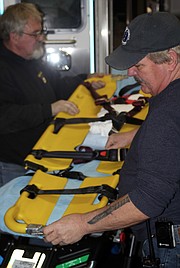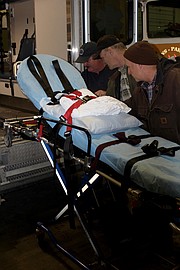Plains-Paradise Rural Fire Department conducts training
The Plains-Paradise Rural Fire Department, Plains Volunteer Fire Department, and the Plains Community Ambulance crews were hard at work last week as they conducted training on lift assists and loading the new hydraulic cot into the ambulance properly. The training was held at the Plains-Paradise Rural Fire Department building, located at 20 Old Airport Road in Plains.
“We do trainings twice a month, on the second and fourth Thursday of every month,” Fire Chief James Russell said.
Approximately 20 people attended the training, having hot dogs, homemade cookies and warming up by a fire made with pallets behind the firehouse. Just before the training began, there was a call to do a lift assist in Plains.
The training began after a Plains Community Ambulance with Larry Neilson returned from the lift-assist call. The emergency crews assembled into small groups of three or four and moved around to the classroom and vehicle bay inside the building. At each location there was one person giving information and a demonstration with each piece of equipment. The equipment brought out and demonstrated included new hydraulic cot, a Stair Chair, a backboard with a Back Raft and a scoop stretcher.
The new hydraulic cot being used was purchased at a cost of $17,000 and is very sensitive to manipulate. Those attending the training were warned to be careful on where they placed hands and fingers when operating the hydraulics, as the cot can quickly move down and pinch fingers if they are improperly placed on the equipment. The cot is loaded onto a long narrow track in the ambulance and then locked into place. The track system will keep the cot from moving should the vehicle become inverted. The track system may help reduce any potential injuries to the patient, EMTs, driver and anyone else in the ambulance.
The Stair Chair is used to move a patient up or down stairs. The unique feature to this piece of equipment is the two manual rotating tracks attached to the back of the chair, which help guide the chair down the stairs in a less jarring motion.
Neilson discussed and demonstrated the proper use of the backboard and Back Raft.
“We sometimes use either head blocks or towel rolls with the backboard and Back Raft. The C-Collars are being debated as possibly causing more pain and injury. There are new regulations and state protocols that require the use of the $35 Back Raft on all backboards,” he said.
The Back Raft has individual ribs and can be manually inflated using a hand pump to help support the back of the patient who is on the backboard.
The scoop stretcher is composed of two pieces that can be used for a patient who is lying on the floor or ground. Each half of the stretcher is moved up to the patient who is gently rolled onto it and then the spider straps will be secured around the patient.
“We are not running. Walk quickly with smooth steps. Everyone must communicate if there is a rock, tree limb, or anything else in the way. Communication is critical,” Neilson said.
“We are doing OK with volunteers. There is always a question if we are going to be in the same position or not in a few weeks,” Russell said.
The Plains Rural Fire Department currently has 19 volunteer firefighters.
For more information about becoming a volunteer with the Plains-Paradise Rural Fire Department, contact Russell at 406-493-5601 or visit www.pprfd.com.
Reporter Douglas Wilks can be reached at dwilks@vp-mi.com or 406-826-3402.









